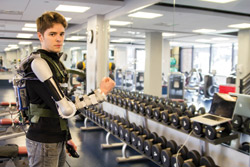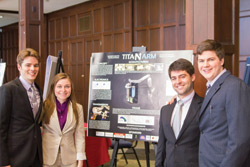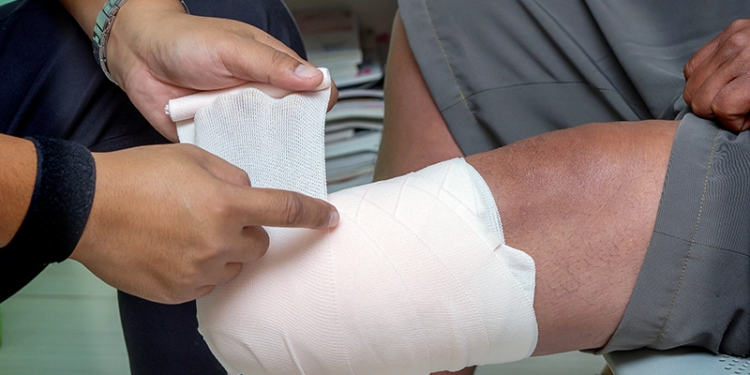
Titan Team member Niko Vladimirov demonstrates the arm’s capabilities. Photographs courtesy of Titan Team.
A team of mechanical engineering students at the University of Pennsylvania (Penn), Philadelphia, have developed an untethered, powered, low-cost exoskeleton arm that has implications for use in the rehabilitation and physical therapy of shoulder and elbow injuries, assistive mobility, and assistive lifting.
The exoskeleton weighs 18 pounds, can lift 50 pounds, and offers three degrees of freedom. It is made of 38 separate aluminum components along with salvaged material, including a scuba diving back plate and the straps from a military-grade backpack, and costs less than $2,000 to manufacture. A joystick is used to drive the control of the actuated elbow joints, allowing for a bicep curl and tricep extension. A switch drives the ratchet-and-pull braking system. A large direct-current (DC) motor powers the unit. On-board sensing can collect range of motion or strength data, which can be accessed remotely. This could allow a physician to monitor a patient’s physical therapy or rehabilitative progress remotely, the team said.
The project garnered second place in the 2013 Senior Design Project Competition for students in the Penn engineering program and the Judge’s Award for Overall Project Excellence – Mechanical Engineering Department, as well as first place at the Cornell University Systems Engineering, Ithaca, New York, 2013 Cornell Cup USA, a college-level design competition to aid student teams “to become the inventors of the newest innovation applications of embedded technology.”

Titan Team, from left: Elizabeth Beattie, Vladimirov, Nick McGill, and Nick Parrotta.
The four team members have said they are all attending graduate school at Penn, where they will work on subsequent iterations of the exoskeleton, to include replacing the joystick control with EMG sensing, adding a second arm to the suit, and implementing actuation at the structural shoulder joint.




